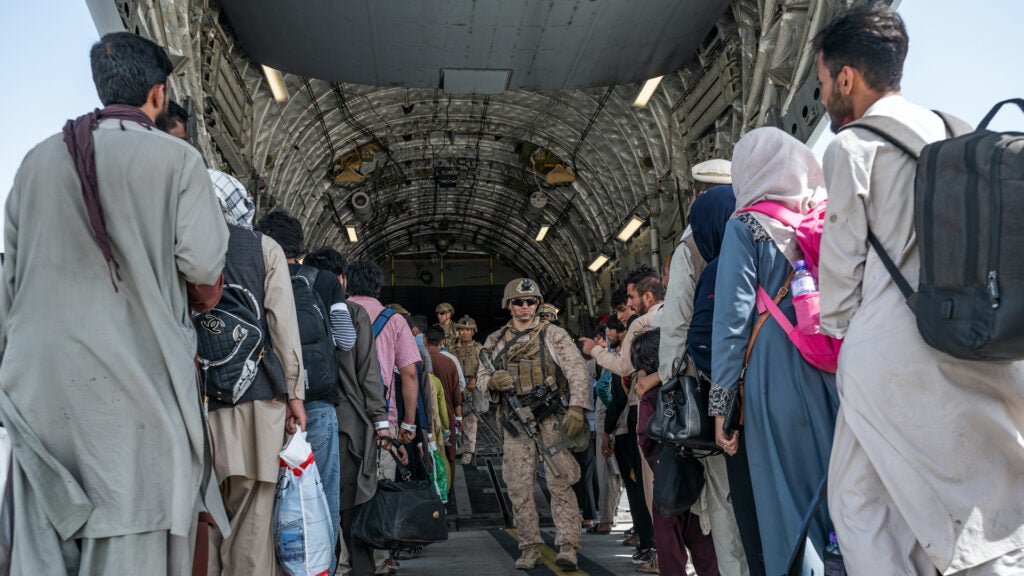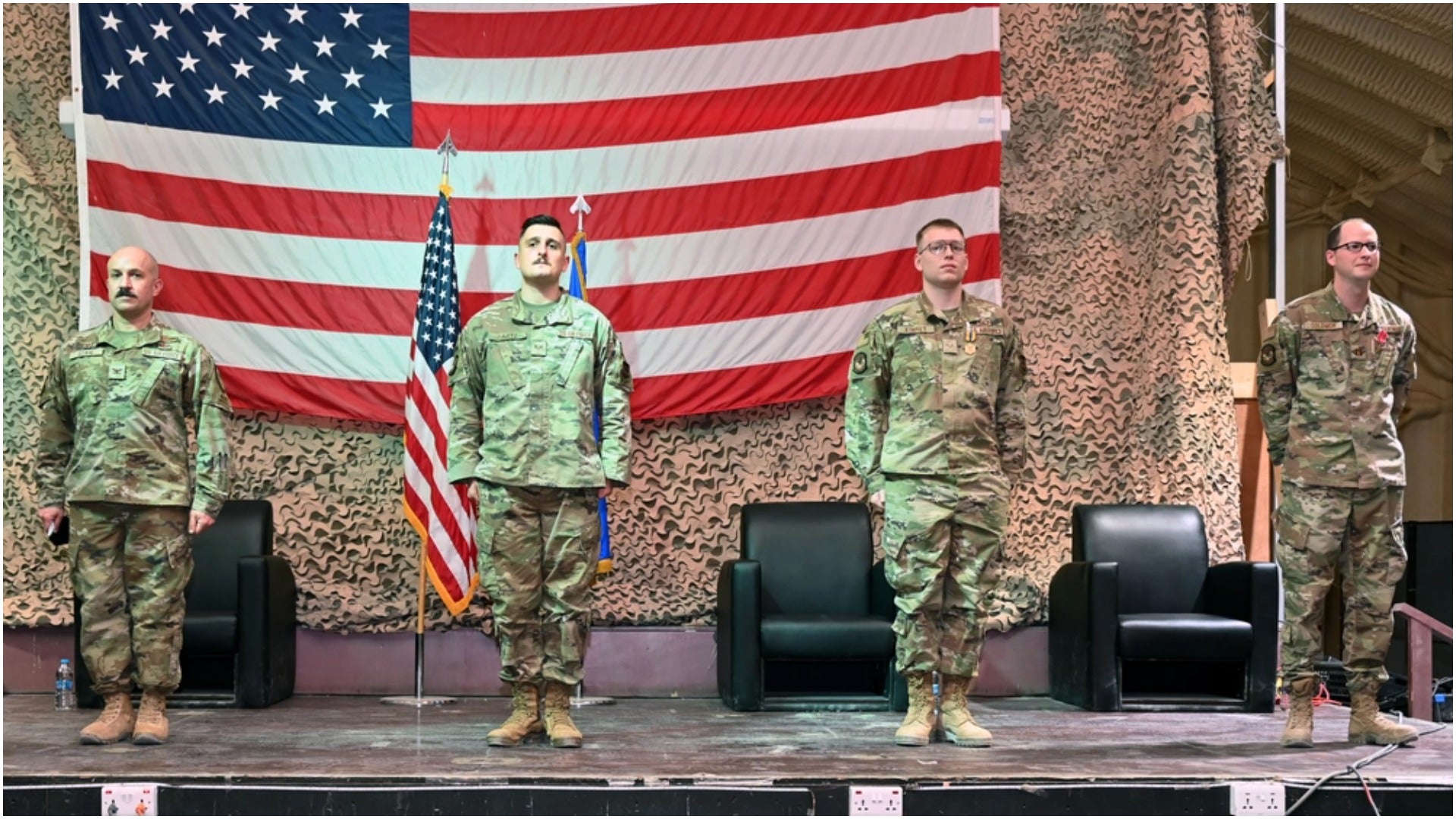Moving more than 124,000 people out of an airport in a matter of weeks takes more than pilots: it also takes planning. Few know this better than Air Force Captain Adam Solomon, who received a Bronze Star medal earlier this month for ‘meritorious service’ while coordinating the massive airlift that took place. marked the end of the US war in Afghanistan in August.
As the headlines were filled with lines of Afghan refugees heading for C-17 transport planes, Solomon worked behind the scenes to ensure that the entire operation, which involved hundreds of planes and several allied nations , went smoothly. To complicate matters, the airman had to do everything under the risk of enemy fire, and he also had to work with the invading Taliban forces to get as many refugees out safely as possible.
“None of us could have known that in a few weeks the largest non-combatant evacuation operation in US history would take place as 124,334 humans were released,” he said. said Lt. Col. Brian Stahl, commander of the 332nd Expeditionary Force. Operations Group, during the awards ceremony Jan. 7, according to an Air Force Press release. “We were controlling the busiest and most dangerous piece of sky in the world…because a few dozen of our wings pushed forward despite the acute danger.”
Specifically, Solomon and a four-man team coordinated communications for thousands of military and allied partners and used a “new sequencing tool” that “exponentially increased outbound evacuation flights,” the report says. Press release.
Although details are vague on what exactly the “new sequencing tool” was, it made such a big difference in streamlining air traffic coordination that it was “hailed as a Department of Defense benchmark and informed of the President of the United States” and senior officials. of other nations. Just to give an idea of the scale of the aircraft involved: an Air Force official told Task & Purpose in September that the service had committed more than 230 aircraft to the effort, including C-17s. , C-5 Galaxies, KC-10, KC-135 and KC-46 tankers and C-130 turboprop transports. This group comprised more than half of the subsidiary’s fleet of 222 C-17s.
“In terms of scale, this was a deck operation,” Air Mobility Command spokesman Capt. Christopher Herbert said at the time.
Aside from sequencing outbound flights, Solomon also “led diplomatic and strategic activities” during a meeting with the Taliban’s aviation minister, and he also “decreased tensions between representatives of several countries” after an Islamic State suicide bombing on August 26 killed 13 US service members. and 170 Afghan civilians outside one of the gates of Hamid Karzai International Airport.
The fact that a relatively low-ranking airman like a captain was handling international diplomacy on the ground shows just how much responsibility Salomon had during the operation. In a way, it also represents how well Airmen can step in to meet a challenge when given the latitude to do so. It’s a concept the Air Force has tried to encourage as it prepares for a potential war with China, where disrupted supply chains and communications networks mean Airmen will have to work more independently and in small groups than they do in the sprawling bases that they currently are. used to.
“Setting up and operating a small airport terminal with minimal supplies, equipment, people, etc., is almost like the Air Force’s dream,” said the chief sergeant. Daniel Fajardo, one of several dozen airmen who launched and recovered planes from the small Pacific island of Tinian during a training exercise last summer. “Like, that’s what we joined the service to do – those kinds of things where we act alone, away from the main hub. It was definitely an adventure.
Back in Kabul, Solomon wasn’t the only Airman having to work outside of his usual job description. Lead Airmen Dakota Bartz and Andrew Kimrey, both air traffic controllers for radar approach with the 332nd Expeditionary Operations Support Squadron, also doubled up as security forces and international liaison during the withdrawal from Afghanistan. The two airmen received the Air Force Commendation Medal with a Combat Device in part because, according to the press release, they joined with U.S. Marines to form a human wall to keep Afghan refugees from crowding the runways of the airport, as they had done earlier during the evacuation. They also helped set up a “safe zone” under threat of sniper fire, bringing more than 1,500 refugees to safety, according to the press release.
Also known as RAPCON, radar approach control air traffic controllers guide pilots to land and help them take off, especially when bad weather makes it difficult to see out of the cockpit window or when planes are too far away for the air traffic control tower controllers can see them.
“You may have many planes in your area that all fly differently,” the master sergeant said. Monica Warren, 27th Special Operations Support Squadron Air Traffic Control, Deputy Chief Controller a press release from 2017 about RAPCON. “You have to think about how fast everyone is going, what direction they are heading, what kind of maneuvers they are capable of, who should go first, who should go second. We need to process all of this information to make sure we’re telling everyone to make the right choices at the right time to make it all go well.

The efforts of senior Airmen Bartz and Kimrey ensured that there were no disastrous mid-air collisions amid this congested airspace. Kimrey even at one point guided an Afghan general through the evacuation effort, according to the press release. The fact that they did all this work between security shifts is pretty much the definition of the concept of “all-around airmen” that Air Force leaders have been preaching for the past few years.
“Most importantly, we need to empower our amazing Airmen to solve any problem,” Gen. Charles Brown Jr. said shortly after becoming Air Force chief of staff in August 2020. “We must value versatile and adaptable team builders, and courageous problem solvers who demonstrate value in diversity of thought, ingenuity and initiative.”
The stellar performance by Solomon, Bartz and Kimrey was just the latest from members of the 332nd Expeditionary Operations Group, their commander, Lt. Col. Brian Stahl, said. The 332nd EOG grew out of the 332nd Fighter Group, whose members were better known as the Tuskegee Airmen, the first black airmen in the US Army. These early members painted the tail of their aircraft red, earning them the nickname “Red Tails”.
“As Red Tails, we stand together for a brief moment, placed in each other’s lives to achieve something greater than any individual or unit, and all for the good of our nation,” said Stahl at the awards ceremony. “We will not let this opportunity pass.”
What’s hot on Task and objective
Want to write for Task & Purpose? Click here. Or check out the latest stories at our homepage.

